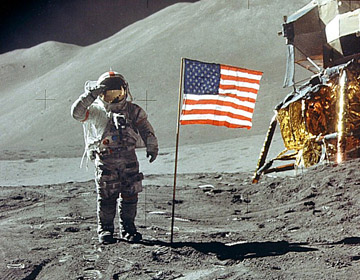Guess the President doesn't want to spend a trillion dollars on something like NASA. He'd rather spend the money on something foolish...
Yeah, like the health of humans instead of moon rocks.

The irony of this latest bitchfest is that if Obama HAD planned for a few trillion in further space exploration, the asshole cons would be screaming bloody murder that it's just another "socialist" program that will provide jobs only to gubmit employees.
To talk about funding for space in the trillions of dollars is to skew the whole reality. The funding for NASA's full budget is only 2% of your $-trillion, and in 2007 (before the current budget fractures) it amounted to only $5.00 out of a thousand. The budget changes that will cause all these planning changes to NASA's future programs only about to about seventy-five-cents out of every thousand dollars budgeted, something different entirely from what will be spent, which always exceeds on spending on budget.
For perspective about what NASA/Space Program has meant to medicine and the health of people worldwide here are some benefits:
Health and Medicine - NASA Spinoffs
DIGITAL IMAGING BREAST BIOPSY SYSTEM - The LORAD Stereo Guide Breast Biopsy system incorporates advanced Charge Coupled Devices (CCDs) as part of a digital camera system. The resulting device images breast tissue more clearly and efficiently. Known as stereotactic large-core needle biopsy, this nonsurgical system developed with Space Telescope Technology is less traumatic and greatly reduces the pain, scarring, radiation exposure, time, and money associated with surgical biopsies.
BREAST CANCER DETECTION - A solar cell sensor is positioned directly beneath x-ray film, and determines exactly when film has received sufficient radiation and has been exposed to optimum density. Associated electronic equipment then sends a signal to cut off the x-ray source. Reduction of mammography x-ray exposure reduces radiation hazard and doubles the number of patient exams per machine.
LASER ANGIOPLASTY - Laser angioplasty with a "cool" type of laser, caller an excimer laser, does not damage blood vessel walls and offers precise non-surgical cleanings of clogged arteries with extraordinary precision and fewer complications than in balloon angioplasty.
ULTRASOUND SKIN DAMAGE ASSESSMENT - Advanced instrument using NASA ultrasound technology enables immediate assessment of burn damage depth, improving patient treatment, and may save lives in serious burn cases.
HUMAN TISSUE STIMULATOR - Employing NASA satellite technology, the device is implanted in the body to help patient control chronic pain and involuntary motion disorders through electrical stimulation of targeted nerve centers or particular areas of the brain.
COOL SUIT - Custom-made suit derived from space suits circulates coolant through tubes to lower patient's body/ temperature, producing dramatic improvement of symptoms of multiple sclerosis, cerebral palsy, spina bifida and other conditions.
PROGRAMMABLE PACEMAKER - Incorporating multiple NASA technologies, the system consists of the implant and a physician's computer console containing the programming and a data printer. Communicates through wireless telemetry signals.
OCULAR SCREENING - NASA image processing techniques are used to detect eye problems in very young children. An electronic flash from a 35-millimeter camera sends light into the child's eyes, and a photorefractor analyzes the retinal reflexes, producing an image of each eye.
AUTOMATED URINALYSIS - NASA fluid dynamics studies helped development of system that automatically extracts and transfers sediment from urine sample to an analyzer microscope, replacing the manual centrifuge method.
MEDICAL GAS ANALYZER - Astronaut-monitoring technology used to develop system to monitor operating rooms for analysis of anesthetic gasses and measurement of oxygen, carbon dioxide, and nitrogen concentrations to assure proper breathing environment for surgery patients.
VOICE-CONTROLLED WHEELCHAIR - NASA teleoperator and robot technology used to develop chair and manipulator that respond to 35 one-word voice commands utilizing a minicomputer to help patient perform daily tasks, like picking up packages, opening doors, and turning on appliances.
Other spinoffs in this area include: Arteriosclerosis detection, ultrasound scanners, automatic insulin pump, portable x-ray device, invisible braces, dental arch wire, palate surgery technology, clean room apparel, implantable heart aid, MRI, bone analyzer, and cataract surgery tools.


